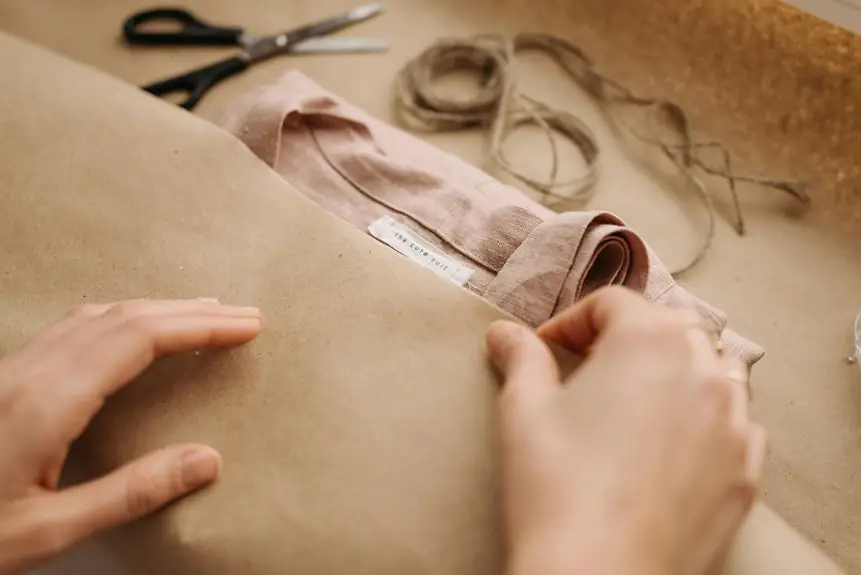Crepe fabric offers a unique crinkled texture and elegant drape, making it perfect for everything from evening gowns to suits and home decor. You’ll find types like silk, wool, and polyester crepe, each with distinct weight and feel. It’s wrinkle-resistant and lightweight, yet durable. Caring for crepe involves gentle washing, careful drying, and proper storage to keep it looking sharp. Keep exploring to reveal tips on choosing, sewing, and styling this versatile fabric for your projects.
Table of Contents
Key Takeaways
- Crepe fabric features a distinctive crinkled texture, excellent drape, and wrinkle resistance, available in silk, wool, polyester, and georgette types.
- Silk crepe offers luxury and smoothness, wool crepe provides warmth, georgette is lightweight and sheer, while polyester is durable and budget-friendly.
- Common uses include elegant dresses, suits, evening gowns, and home decor items like curtains and decorative pillows.
- To care for crepe, hand wash or use a gentle cycle with cold water and mild detergent, avoiding bleach and wringing.
- Dry crepe garments flat or hang carefully using padded hangers, store in cool, dark places, and iron on low heat if needed.
What Is Crepe Fabric?
Crepe fabric is a textured material known for its distinctive crinkled or pebbled surface. When you touch it, you’ll notice the slightly rough feel that gives it character and depth.
This texture comes from the special weaving technique or the yarns used in production, which are twisted tightly to create that signature grainy look. You’ll find crepe made from various fibers like silk, wool, or synthetic blends, each offering unique qualities.
It’s lightweight yet drapes beautifully, making it popular for garments that need both structure and flow. Because of its texture, crepe resists wrinkles better than many smooth fabrics, so you won’t have to fuss over it as much.
Understanding what crepe is helps you appreciate its versatility in fashion and design.
Different Types of Crepe Fabric
Understanding the texture and characteristics of crepe fabric sets the stage for exploring its various types.
Grasping crepe fabric’s texture and traits opens the door to its diverse varieties and uses.
When you look at crepes, you’ll notice they come in several varieties, each with unique qualities.
For example, Silk Crepe offers a luxurious feel and a smooth drape, perfect for elegant garments.
Wool Crepe provides warmth and a heavier texture, ideal for suits and coats.
Georgette Crepe is lightweight and slightly sheer, which makes it great for flowy dresses and blouses.
Meanwhile, Polyester Crepe is durable, easy to care for, and budget-friendly.
As you explore these types, consider what you want from your fabric—whether it’s breathability, weight, or sheen—to pick the best crepe for your project.
Key Characteristics of Crepe
The unique texture of crepe fabric comes from its distinct crinkled or pebbled surface, which gives it both visual interest and a tactile quality you can feel. This texture results from tightly twisted yarns woven or knitted in a way that creates that signature grainy appearance.
You’ll notice crepe’s excellent drape, allowing it to flow gracefully, making it ideal for elegant garments. It’s also lightweight but durable, resisting wrinkles better than many other fabrics, so you won’t have to fuss with constant ironing.
Additionally, crepe can range from matte to slightly lustrous, depending on the fiber content—silk crepe tends to shine softly, while wool or polyester crepes lean more matte.
Common Uses for Crepe Fabric
With its distinctive texture and graceful drape, crepe fabric suits a wide range of clothing and decor applications.
When you choose crepe, you tap into versatility and elegance.
Here are three common ways you might use crepe fabric:
- Apparel: Crepe is popular for dresses, blouses, and suits because it hangs beautifully and resists wrinkles, giving you a polished look.
- Evening Wear: Its luxurious feel and fluid drape make crepe ideal for gowns and formal attire, adding sophistication to special occasions.
- Home Decor: Crepe also works well for curtains and decorative pillows, lending texture and softness to your living space.
How to Choose the Right Crepe for Your Project
When choosing crepe for your project, you’ll want to take into account fabric weight carefully to match your design’s needs.
Think about the texture you want—whether smooth, crinkled, or grainy—since it affects both look and feel.
Picking the right crepe guarantees your project turns out just the way you envision.
Fabric Weight Considerations
Because fabric weight directly affects drape and durability, you’ll want to reflect on it carefully before choosing crepe for your project.
Lighter crepes offer fluidity and softness, ideal for delicate blouses or scarves, while heavier weights provide structure and warmth, perfect for jackets or pants.
Here’s what to take into account:
- Project type – Match weight to garment purpose; lightweight suits flowy dresses, medium weight fits everyday wear, and heavyweight supports outerwear.
- Seasonality – Choose lighter crepes for spring/summer and heavier ones for fall/winter to guarantee comfort.
- Durability needs – Heavier crepes resist wear better, especially for frequently used items.
Desired Texture Effects
Texture plays an essential role in defining the look and feel of your crepe fabric project. When choosing crepe, consider whether you want a fine, smooth texture or a more pronounced, pebbly surface.
Lightweight crepes with subtle granulation work well for delicate blouses or scarves, offering elegance without bulk. Heavier crepes with a pronounced crinkle add depth and structure, perfect for tailored jackets or skirts.
You’ll also want to think about drape—softer textures flow gracefully, while stiffer ones hold shape better. Match the texture to your project’s function and aesthetic.
Sewing Tips for Working With Crepe
Mastering three key sewing techniques can make working with crepe fabric much easier.
First, always use sharp, fine needles (size 70/10 or 80/12) to prevent snags.
Second, stabilize the fabric with tissue paper or a lightweight interfacing when cutting and sewing to avoid stretching or distortion.
Third, opt for a narrow zigzag stitch or a straight stitch with a short stitch length to maintain the fabric’s flexibility and prevent puckering.
- Use sharp needles (70/10 or 80/12) to avoid damage.
- Stabilize crepe with tissue paper or lightweight interfacing.
- Choose short straight stitches or narrow zigzag stitches for flexibility.
These tips help you handle crepe’s delicate texture and achieve professional results.
Caring for Crepe Garments
To keep your crepe garments looking their best, it’s important to follow specific washing tips that prevent damage.
You’ll also want to use proper drying methods to maintain the fabric’s texture and shape.
Finally, knowing how to store crepe correctly will help extend the life of your pieces.
Washing Tips
Although crepe fabric is delicate, you can keep your garments looking fresh by following some simple washing tips. Proper care helps maintain crepe’s unique texture and prevents damage.
- Use cold water and mild detergent: Always wash crepe in cold water to prevent shrinkage and avoid harsh chemicals that can weaken fibers.
- Hand wash or gentle cycle: Hand washing is best, but if you use a machine, select the gentle cycle to reduce agitation.
- Avoid wringing: Gently press out excess water instead of twisting or wringing, which can distort the fabric’s shape.
Drying Methods
One key step in caring for crepe garments is drying them properly to preserve their texture and shape.
After washing, gently squeeze out excess water without wringing, which can distort the fabric. Lay your crepe piece flat on a clean, dry towel and roll it up to absorb moisture.
Then, reshape the garment and lay it flat on another dry towel or drying rack. Avoid hanging crepe when wet, as gravity can stretch the fibers and ruin the silhouette.
Keep your crepe away from direct sunlight and heat sources, which can fade colors and weaken fibers. If you must use a dryer, opt for the lowest heat setting and remove the item while it’s still slightly damp to air dry fully.
This careful drying approach keeps your crepe looking fresh and lasting longer.
Storage Recommendations
Since crepe fabric is delicate and prone to wrinkles and stretching, you should store your garments carefully to maintain their shape and texture.
Proper storage helps avoid damage and keeps your crepe pieces looking fresh.
Here are three storage tips to follow:
- Hang with Care: Use padded hangers to support the garment’s shape and prevent shoulder bumps.
- Avoid Overcrowding: Give your crepe garments space in the closet to prevent crushing and wrinkles.
- Protect from Sunlight: Store in a cool, dark place or use garment bags to avoid fading and fabric weakening.
Styling Ideas With Crepe Fabric
When you choose crepe fabric for your wardrobe, you tap into a versatile material that works well for both casual and formal styles.
You can rely on crepe’s natural drape to create elegant dresses or skirts that flow beautifully. For workwear, pair a crepe blouse with tailored trousers for a polished look that’s comfortable all day.
On casual days, try crepe pants with a simple tee for effortless style. Crepe also holds pleats and ruffles well, so don’t hesitate to experiment with textured designs.
If you want to layer, crepe’s lightweight nature makes it perfect under jackets or cardigans without adding bulk.
With crepe, you can easily shift your outfit from day to night by swapping accessories or shoes.
Frequently Asked Questions
Can Crepe Fabric Be Recycled or Is It Eco-Friendly?
Think of crepe fabric like a puzzle—some pieces fit eco-friendly recycling, others don’t. You can recycle natural crepe, but synthetic blends often can’t. So, you’ll want to check the fiber content for greener choices.
What Is the History Behind Crepe Fabric’S Development?
You’ll find crepe fabric dates back to the 15th century, originating in silk weaving centers like France. It developed through unique weaving and finishing techniques, giving it that distinctive crinkled texture you recognize today.
Are There Any Health Concerns With Wearing Crepe Fabric?
Imagine soft petals brushing your skin—crepe fabric usually feels gentle and safe. You won’t face health issues unless you’re allergic to specific fibers. Always check fabric content to avoid irritation or discomfort when wearing crepe.
How Does Crepe Fabric Compare to Chiffon in Durability?
You’ll find crepe fabric generally more durable than chiffon because it resists snags and wrinkles better. Chiffon’s delicate, sheer texture makes it prone to tearing, so crepe’s sturdier weave holds up longer in daily wear.
Can Crepe Fabric Be Dyed at Home Effectively?
Yes, you can dye crepe fabric at home effectively. Just make sure to use the right dye for the fabric type, follow instructions carefully, and test a small piece first to achieve even, vibrant results without damage.
- How to Use Scrim in Costume Design for Ethereal and Layered Effects - June 26, 2025
- How to Sew Scrim Fabric Without Snagging or Tearing - June 26, 2025
- A Beginner’s Guide: How to Rig and Light a Stage Scrim - June 26, 2025







